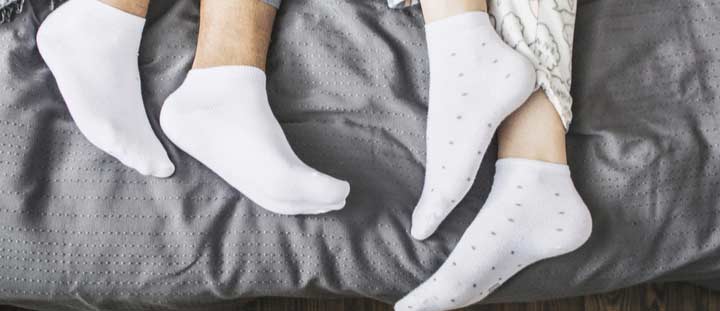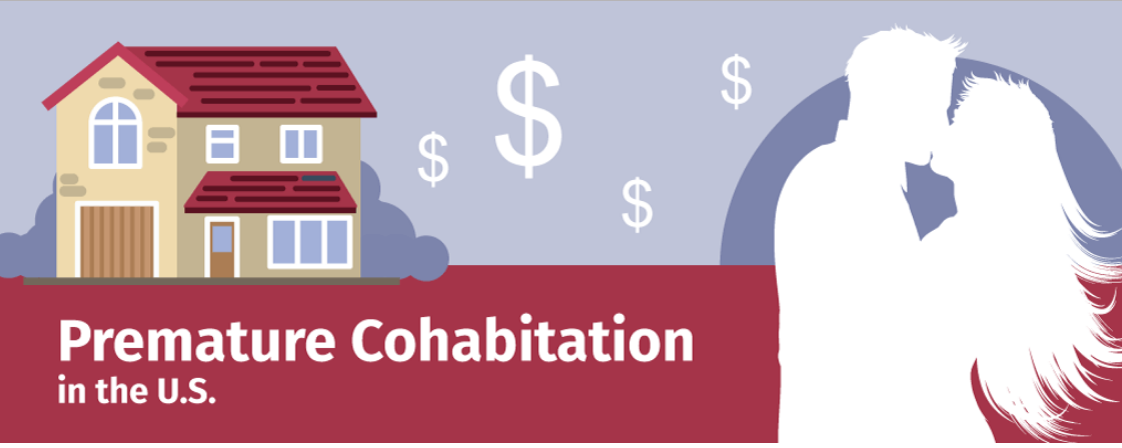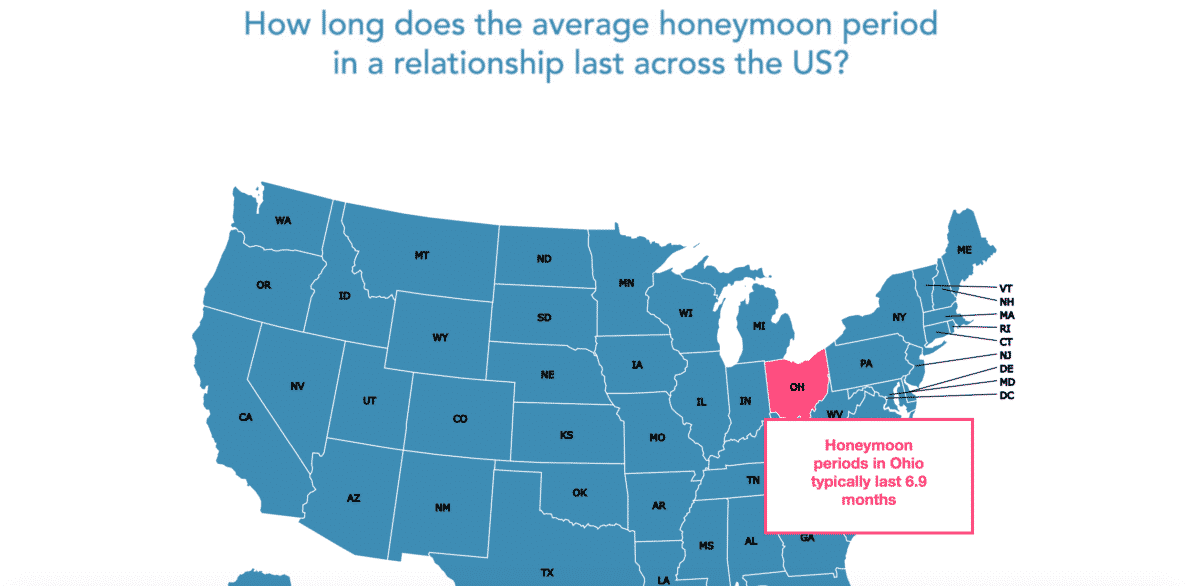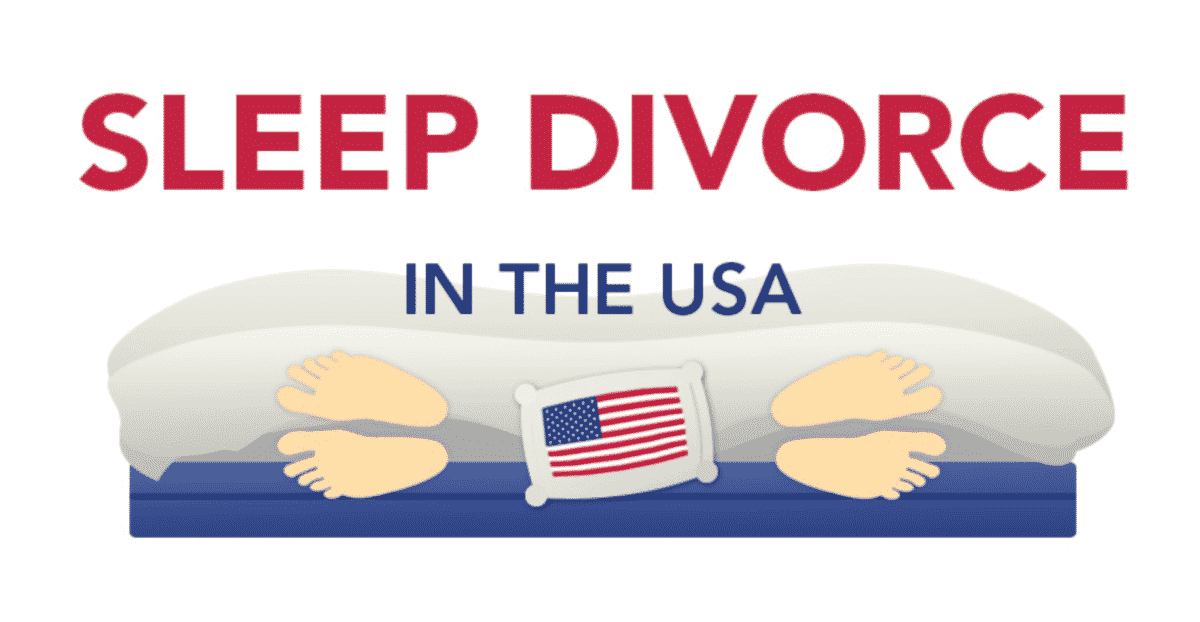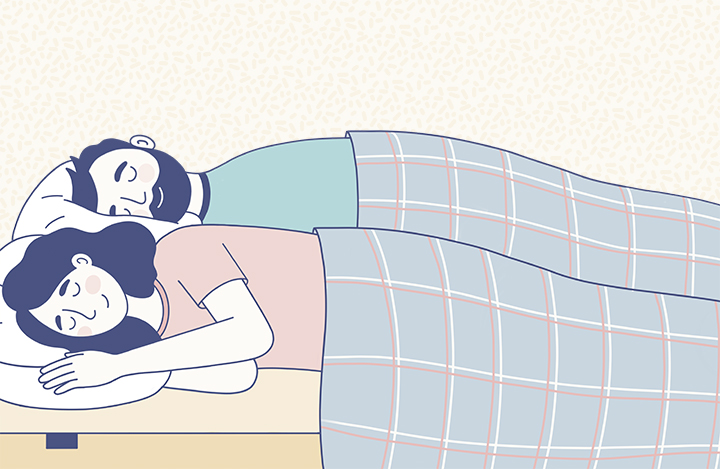
Around the world, millions of adults share a bed with a partner. Particularly in the Western part of the globe, sleeping in the same bed is so common that couples rarely even consider alternatives.
For some couples, the normalization of bed-sharing works out just fine. In fact, research suggests there are several benefits of sleeping with a partner.
But for other couples, sharing a bed doesn’t exactly promote sound sleep. From restlessness and sleep disorders to illness and differing schedules, many partners find they’re not on the same page (or under the same blanket) when it comes to getting adequate rest.
Luckily, plenty of strategies can help partners sleep more soundly. In the following sections, we’ll take a closer look at the potential benefits and downsides of sleeping with a partner. We’ll also detail how a “sleep divorce” works and when it might be useful. Finally, we’ll explore tips for partners looking to enjoy better sleep together. Let’s dive in!
Jump To
Benefits of Sleeping with a Partner | Sleep Problems + Preferences | Sleep Divorce | Couples Sleep Tips | Relationships + Sleep Resources | Final Thoughts
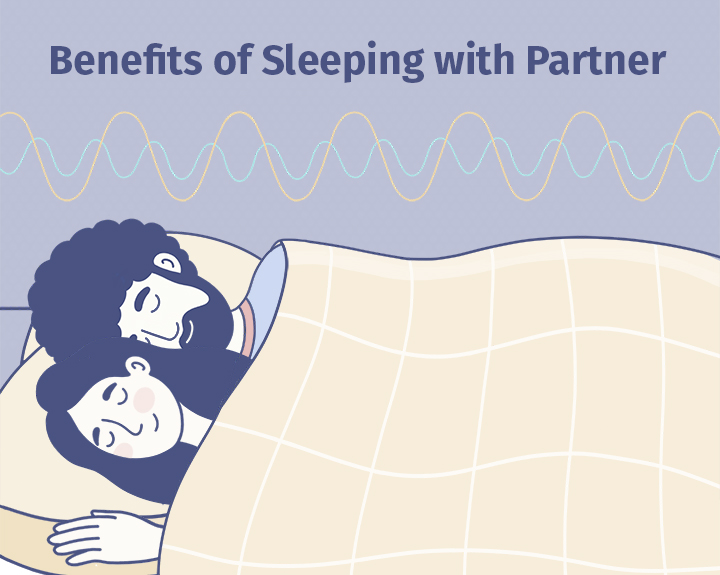
Benefits of Sleeping with a Partner
If you’ve spent any time sleeping with a partner, you can probably name some of the benefits. Nighttime cuddles, for one thing, and a sense of closeness and intimacy. It can also be reassuring to know that, should an emergency happen during the night, you’ll be there for each other.
Turns out, science backs up these and other potential benefits. Dr. Kent Smith, President of the American Sleep and Breathing Academy, says, “A growing amount of evidence shows that couples who sleep together not only remain together, but actually extend their lives.”
Smith lists three reasons why this is the case:
- Stronger relationships. “Sleeping with a significant other increases oxytocin, a chemical that is produced in the same part of the brain that controls your sleep-wake cycle,” Smith says. “Sharing a bed can also help one to feel more connected in their relationship, lowering the risk for developing depression or other mood disorders.”
- Safety in numbers. “Sleeping next to the one you love produces feelings of protection, safety and security,” Smith says. “These feelings and emotions decrease our anxiety level and lower the body’s level of cortisol, the stress hormone, to allow for more peaceful and restorative sleep.”
- Good health. “People with healthy and consistent sleep habits are less likely to become sleep deprived,” Smith says. “Over the long term, sleep deprivation can lead to serious conditions including heart disease, obesity, sleep apnea, and insulin resistance – not to mention fatigue, slower reaction times, a compromised immune system, and irritability.”
Per a variety of studies, here are several other potential upsides of sleeping with a partner:
- Increased REM sleep. One 2020 study found that (heterosexual) couples who sleep together enjoyed about 10% more REM sleep as well as less fragmented REM sleep compared to people who sleep solo. Among other critical functions, REM sleep is essential for memory formation. For that reason, one of the study’s researchers concluded that “sleeping with a partner might actually give you an extra boost regarding your mental health, your memory, and creative problem-solving skills.”
- More sleep overall. A 2015 study found couples who sleep together might not only get more REM sleep; they might enjoy more sleep overall. Couples in the study also demonstrated fewer sleep disruptions and were more likely to fall asleep faster compared to single sleepers.
- Lower blood pressure. A 2017 study suggested couples who demonstrate high levels of “sleep-wake concordance” (i.e. couples who are awake and asleep at approximately the same times throughout the night) may experience lower blood pressure and reduced inflammation overall. This could lower the risk of cardiovascular disease.
- Greater chance of diagnosis. It’s very common for someone to suffer from a sleep disorder such as sleep apnea without even realizing it. Oftentimes, a sleep partner notices the symptoms first, which can prompt the person with those symptoms to seek treatment.
- Healthier routines. Healthy couples may encourage healthy sleep habits — such as going to bed at a reasonable hour, exercising regularly (which is linked with better sleep), and sustaining treatments for any sleep disorders that might be present in one or both partners. This can have a positive impact on sleep quality and quantity.
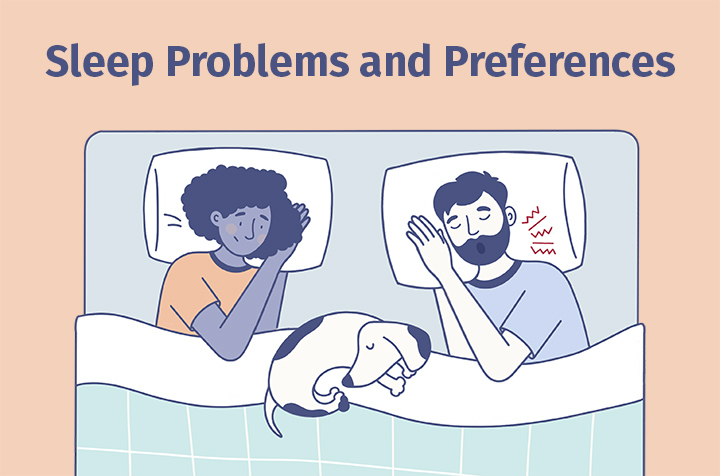
Sleep Problems and Preferences
While sleeping with a partner could offer several benefits, it’s not necessarily the best arrangement for every couple. Various sleep problems and preferences could put a strain on one or both people’s sleep. Below, we’ve detailed some common culprits of sleep problems in relationships.
Snoring and Other Sleep Issues
A 2016 literature review found sleep issues in one or both partners — such as snoring, sleep apnea, or insomnia — can negatively affect sleep for both people and even contribute to relationship issues. What’s more, it’s possible a sleep disorder in one partner could increase the risk of the other person developing a sleep disorder.
When it comes to snoring, “Both partners can contribute to fixing this,” Santini says. “The snoring partner can opt for oral appliances, nasal strips, sleeping on their side, [and/or] maintaining a healthy weight to help reduce or prevent snoring. The other partner can wear sleep earplugs or headphones when sleeping to cut out the noise.”
No matter the condition in question, it might also be helpful to talk to a health professional. For instance, if a snorer has sleep apnea, using a CPAP machine could be safer and quieter, while therapy could assist people with insomnia.
Moving Around
Some people have a sleep disorder, such as restless leg syndrome (RLS), that makes it hard to get comfortable and causes them to move around a lot on the mattress as they try to relieve the tingly sensation in their legs or arms. Other folks are simply prone to tossing and turning in their sleep. No matter the cause of someone’s movements, they can be highly disturbing to their bed partner.
If you or your partner could be suffering from RLS, it’s important to seek medical help. An underlying condition could be provoking RLS, and managing that condition might offer some much-needed relief. A doctor might also prescribe medication for RLS symptoms. Other useful strategies for managing RLS include regular exercise, leg massages, hot or cold packs, and limiting tobacco and caffeine use.
When it comes to run-of-the-mill restlessness, one of the best solutions is a mattress that minimizes motion transfer. On such a bed, the restless partner is less likely to jostle the person who’s trying to sleep. We discuss this in more detail in the “General Tips and Considerations” section, below.
Different Temperature Preferences
It’s a common source of tension in a relationship: One person wants to sleep under a pile of blankets or with the thermostat cranked up, while the other prefers a single sheet or an icy-cold thermostat. Experts generally agree that a cooler room (between approximately 60 and 67 degrees) promotes better sleep. But that doesn’t mean one person has to suffer.
Partners who have different temperature preferences might try using separate bedding so each partner can meet their respective preferences. Another strategy? Aim a fan at the person who sleeps hotter (and try to keep the breeze away from the other person). Or one person could sleep in warmer pajamas, such as flannel, while the other sticks to a thin, breathable t-shirt. Smith says cotton pajamas are ideal, “as they are breathable and can help prevent overheating.”
Noise and Tech Use
Some people enjoy falling asleep to the sound of TV, music, or a white noise machine, while others require silence to drift off to dreamland. One 2021 study of 289 cohabitating adults found people often feel frustrated when their partner wants to spend time alone with the TV rather than engaging in physical or emotional intimacy. In contrast, partners who watch TV or use other tech together before bed tend to feel more satisfied with their sleeping arrangement.
If you and your partner aren’t on the same page when it comes to noise, the person who prefers to use tech before bed could invest in wireless TV headphones or headband sleep headphones. You might also enlist the help of a TV with a built-in sleep timer. And be sure to turn the brightness down in the hours leading up to bed, since the blue light emitted by TVs and other electronics can disrupt circadian rhythms.
Light Usage
Another common conflict among bed partners? Light. Some people prefer sleeping in the pitch-black, while others need a nightlight or some other light source to sleep comfortably. People with insomnia might turn on a light so they can read or engage in another activity in the middle of the night, but this can disrupt their partner.
Luckily, there are several strategies available to partners with opposing light preferences. If one partner likes to sleep in the dark and the other needs some light, the person who prefers the dark could use an eye mask while the other person uses a dim night light. Bookworms who enjoy reading late at night could use a book light rather than an overhead light or a lamp.
Opposing Bedtime and Wake Up Times
Every person has their own sleep-wake patterns, which are dictated by many factors including work schedules, children, pets, and good ol’ biology – i.e. your “chronotype.” The 2016 review cited above found that a difference in sleep-wake cycles can cause one or both partners to suffer from poor or insufficient sleep. In particular, women seem to have a preference for partners who share a similar sleep-wake pattern.
It might not be possible to sync up every bedtime and wake up, but it is worth moving toward more synchronization when you can. Research suggests partners with mismatched sleep patterns have less marital satisfaction than couples who head to bed around the same time. If it simply doesn’t work to sleep and rise at the same time, it’s critical to respect your partner’s sleep patterns.
Early risers should avoid turning on bright lights or making noise in the bedroom before their partner is up. They could also stash a vibrating alarm clock in their pillow so a loud alarm doesn’t wake up the other person. Night owls can be respectful by dimming the lights and silencing electronics (or using headphones) when their partner turns in.
Illness
Whether short-term or chronic, illness can make it more challenging for either or both partners to sleep soundly through the night. The 2016 review cited above found the early stages of an illness can be particularly disruptive as partners adjust to their new circumstances.
For a short-term illness, a simple solution is to have the non-ill partner sleep on the couch or in a guest bedroom. In many cases of chronic illness, it could work for both partners to continue sharing the bed, but perhaps with some tweaks (e.g. using an adjustable bed that allows each person to change the bed’s firmness depending on how they’re feeling).
In some cases, partners might choose to sleep in separate beds or rooms permanently. For more on this, check out the “Sleep Divorce” section below.
Relationship Conflicts
The 2009 and 2016 reviews cited above found the quality of a relationship — or lack thereof — can have a big impact on each partner’s ability to obtain quality sleep. The review suggested that people in “distressed” relationships are more likely to experience sleep disturbances and more likely to develop sleep disorders. This is probably because conflict-riddled relationships can provoke anxiety and/or depression, both of which are linked with poorer sleep quality. In a vicious cycle, poor sleep can increase the chance of conflict within a relationship.
If you and your partner have been fighting a lot, it’s probably worth going to couples therapy. If that doesn’t yield improvements, it might be time to reconsider the relationship — for both your mental wellbeing and your sleep health.
Sleep Positions
Sleep positions can be another source of friction in a relationship. Maybe you want to sleep on your back, but your partner is spread-eagle on their stomach and keeps kicking their leg into yours. Or maybe you both like to sleep on your sides facing each other, so you keep waking up to stinky morning breath.
“For couples looking to get a good night’s sleep together, there are a variety of sleep positions that can help aid a better night’s sleep,” Smith says.
Those include spooning, “which is known to be comforting and is good for warming up during cold nights.” Sleeping back-to-back is “a good way to enjoy a night’s rest without disturbing the other person too much,” and side-by-side on your backs allows both partners to move around a bit “without disturbing each other that much.” Sleeping side-by-side can also be “especially comfortable in warmer temperatures,” Smith says, “as it keeps the front of your body cool.”
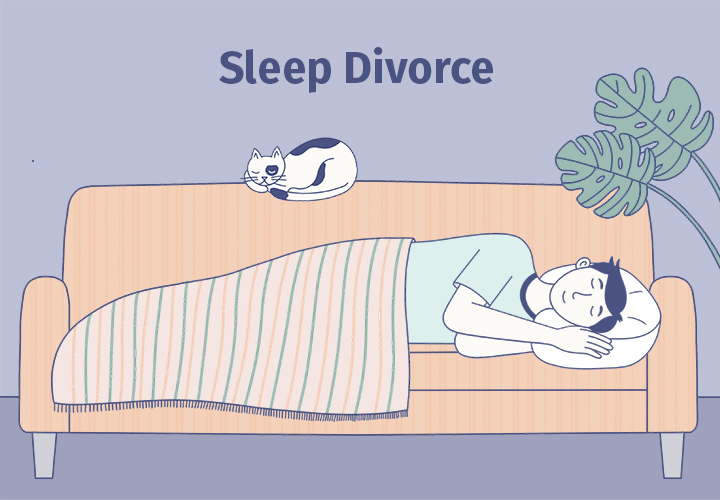
Sleeping in Separate Beds (Sleep Divorce)
When couples aren’t obtaining quality sleep in the same bed, it may be time to consider sleeping separately. This is referred to as a “sleep divorce,” or when couples consistently sleep in different spaces. Generally, the rest of the relationship remains unchanged.
While the concept of a sleep divorce might sound extreme to some couples, it’s much more common than you might think. Our own survey of 3,000 Americans found just over 30% of respondents nationwide would like a sleep divorce. These findings come on the heels of a 2018 poll of 2,000 Americans, which found a whopping 47% of respondents would prefer to sleep without their partner and 19% of respondents blamed their partner for their poor sleep quality.
Why might some partners prefer to sleep solo? The 2018 poll found common reasons include being disturbed by a partner’s snoring, fighting over the bed covers, feeling overheated, and waking up with the other person’s hair in their face.
In many cases, a sleep divorce increases the chances that both partners will obtain better sleep. This is critical, since sleep deprivation can lead to a host of physical and mental health issues, including type 2 diabetes, depression, impaired work performance, and reduced relationship quality.
Better sleep often results from the elimination of whatever factor was making it hard for one partner to sleep: for instance, no more snoring, blanket hogging, or tossing and turning. Some couples also find their sexual intimacy increases after a sleep divorce, as not sharing a bed leads to more exciting sex.
If you and your partner choose to try a sleep divorce, keep in mind that communication is key. Sleeping in separate beds could make either partner a little lonely or insecure, so make space to process thoughts and feelings together. Set a timeline for a sleep divorce trial, then decide whether to make it permanent based on how both partners are feeling. If you choose to stick with it, consider scheduling times for sexual and emotional intimacy. It’s also worth investing in a good mattress for sex. Basically, you want to reduce any impediments to intimacy since you won’t be sharing as much time in bed.
Sleep Tips for Couples
Not quite ready for a sleep divorce? The following strategies could help you and your partner sleep more soundly in the same bed.
- Identify and manage underlying health conditions. If one or both partners suffer from snoring, sleep apnea, insomnia, restless leg syndrome, or other sleep issues, it’s a good idea to seek the input of a health professional. “To realize the health benefits of sleeping with a partner, as well as mitigate further health consequences, it’s important to address any underlying sleep issues,” Smith says.
- Practice proper sleep hygiene. Regardless of whether you sleep with a partner or alone, good sleep hygiene significantly increases your chances of sleeping well. This includes things like keeping the bedroom cool, dark, and quiet; keeping electronics out of the bedroom; changing the sheets on a regular basis; adopting a relaxing bedtime routine; sticking to a regular bedtime; and so on.
- Use separate bedding. Many partners have different preferences when it comes to the type and amount of bedding they use. Especially if you have a queen or king mattress, there’s a very easy fix for this: use different bedding on each side of the bed. Smith recommends choosing bedding that is “made of a natural material like cotton, which can help prevent overheating.” If the issue is that one partner hogs the covers, consider using a Big Blanket. As the name implies, it’s an enormous blanket that should give both partners plenty of coverage.
- Modify the temperature. If one person sleeps cold and the other person is prone to sleeping hot, here’s an easy solution: Place a fan only on the hot sleeper’s side of the room. If both partners are prone to sleeping hot, try using copper-infused sheets, which could create a cooler sleep surface.
- Invest in a low motion transfer mattress. If your partner is prone to tossing and turning during the night, it could be worth investing in a low motion transfer mattress. This helps minimize movement across the surface of the bed so partners are less likely to disturb each other. Memory foam mattresses are usually a great choice; soft memory foam helps absorb movement.
- Use sleep aids. Plenty of products can help partners obtain better shut-eye, from blackout curtains (which minimize light pollution in the bedroom) to eye masks (which allow one partner to sleep in a darker environment), earplugs (which can block out the noise of electronics), and so on. There’s no need to split up when a $15 fix could make a world of difference.
- Consider sleeping naked. Smith says sleeping in the buff “has many potential benefits,” including temperature regulation, increased intimacy, higher sperm count, lower risk of yeast infections, and more restful sleep. What’s more, “skin-to-skin contact increases the hormone oxytocin, which can bond couples, drawing them closer emotionally and physically,” Smith says. “Lying next to your partner while naked can also increase sexual desire, leading to greater intimacy.”
Additional Relationships + Sleep Resources
Final Thoughts
There are many benefits to sleeping in the same bed as a partner, from reduced anxiety to greater intimacy and increased REM sleep. But for some couples, sharing a bed can become a source of stress. Illness, sleep disorders, or different preferences around bedroom lighting and temperature can all take a toll on one or both people’s sleep.
If you and your partner aren’t enjoying deep Zzzs, here’s some good news: a variety of strategies can help you sleep more soundly, from managing underlying health conditions to using separate bedding, using sleep aids such as eye masks or earplugs, and even sleeping in the buff. If all else fails, it might be time to consider a “sleep divorce.” Far from being a death knell for a relationship, sleeping in separate rooms can help both partners feel better and more well-rested, which often leads to healthier partnerships.
The bottom line? Both you and your partner deserve to sleep well on a regular basis, and you need to if you want to preserve your physical and mental health. So make drifting off to dreamland a priority in your relationship, and don’t settle until you’re both enjoying sound sleep.
